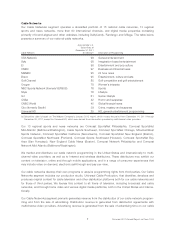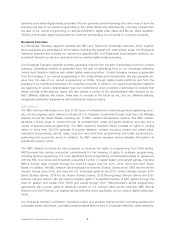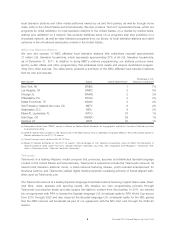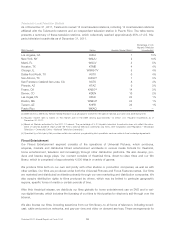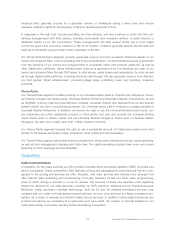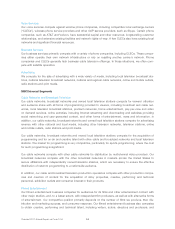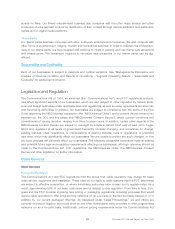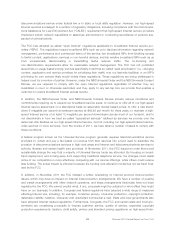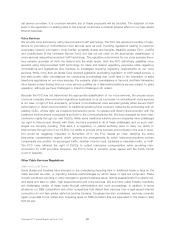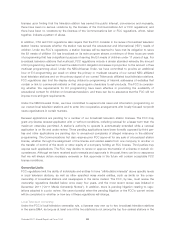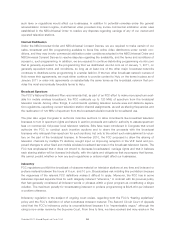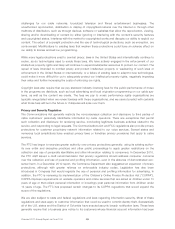Comcast 2011 Annual Report Download - page 19
Download and view the complete annual report
Please find page 19 of the 2011 Comcast annual report below. You can navigate through the pages in the report by either clicking on the pages listed below, or by using the keyword search tool below to find specific information within the annual report.Cable Equipment
The FCC has adopted regulations aimed at promoting the retail sale of set-top boxes and other equipment
that can be used to receive digital video services. With the exception of certain one-way devices, like digital
transport adapters, these regulations prohibit cable operators from deploying new set-top boxes that perform
both channel navigation and security functions. As a result, most set-top boxes that we purchase must rely
on a separate security device known as a CableCARD. In addition, the FCC has adopted regulations aimed at
promoting the manufacture of plug-and-play TV sets and other equipment that can connect directly to a
cable system with a CableCARD and receive one-way video services without the need for a set-top box. In
addition, cable operators must provide a credit to customers who use plug-and-play equipment purchased at
retail and allow them to self-install CableCARDs rather than having to arrange for professional installation. The
FCC also is considering proposals to supplant CableCARDs with another technology that would enable retail
video devices to work on any multichannel video provider system, not just a cable system. These proposals
could impose substantial costs on us and impair our ability to innovate. Federal and state legislators and
regulators also are considering proposals to impose energy efficiency requirements on our set-top boxes and
certain network equipment. In addition, the NBCUniversal Order requires us to fulfill commitments designed
to improve the parental control tools and information available to parents, including providing navigation and
blocking capabilities for certain set-top boxes.
MDUs and Inside Wiring
FCC regulations prohibit exclusive video service access agreements between cable operators and MDUs or
other private residential real estate developments, as well as our enforcement of exclusivity provisions in any
of our pre-existing access agreements. FCC regulations also facilitate competitors’ access to the cable wiring
inside such properties.
Pole Attachments
The Communications Act permits the FCC to regulate the rates that pole-owning utility companies (with the
exception of municipal utilities and rural cooperatives) charge cable systems for attachments to their poles.
States are permitted to preempt FCC jurisdiction and regulate the terms of attachments themselves, and
many states in which we operate have done so. Most of these states have generally followed the FCC’s pole
attachment rate standards. Utility companies initiated a proceeding in 2009 at the FCC seeking to apply the
telecommunications services pole rate formula to all pole attachments over which cable operators provide
phone services using interconnected VoIP technology, which is the type of technology we use for our voice
services. The pole attachment rates applicable to telecommunications services were significantly higher than
the rates we currently pay. In June 2011, the FCC adopted a pole rate formula that reduces the rates for
telecommunications service pole attachments to levels that are at or near the rates for cable attachments, but
utility companies are able to rebut certain presumptions in the new formula, and it is expected that most will
attempt to do so. A group of power utility companies has challenged that ruling in the U.S. Court of Appeals
for the D.C. Circuit.
Vertical Ownership Limit
The FCC is assessing whether to revise a limit on the number of affiliated programming channels that a cable
operator may carry on a cable system. The FCC’s previous limit of 40% of the first 75 channels carried on a
cable system was struck down by a federal appellate court in 2001, although the FCC continues to enforce it.
The FCC previously clarified that, under the 40% limit, cable systems with 75 or more channels must carry at
least 45 unaffiliated channels. Our cable systems routinely carry more than 45 unaffiliated channels, and we
currently comply with the 40% limit. Compliance could become more difficult depending on what regulations,
if any, the FCC adopts.
17 Comcast 2011 Annual Report on Form 10-K


